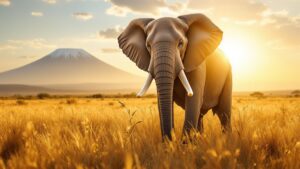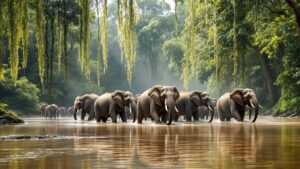Meeting Africa’s Giants: The Thrilling Introduction to African Elephants
If you close your eyes and imagine Africa, chances are the first creature that comes to mind is the African elephant. Towering over the grasses of the savanna, marching in dignified herds beneath the acacia trees, or disappearing into the emerald shadows of ancient forests, the African elephant is the very soul of the continent’s wild heart. No animal embodies the drama, power, and mystery of Africa quite like these giants do. Their presence is so iconic that the landscape itself seems to pulse with the rhythms of their lives—a place where the thundering footsteps of matriarchs echo across plains and forests, carrying the wisdom of generations. Whether glimpsed on a misty morning or heard trumpeting in the heat of the afternoon, African elephants captivate, inspire, and remind us of the wild world’s grandeur.

African Bush Elephant
Meet Loxodonta africana—The True King of the Savannah When you think of the largest land animal on Earth, towering majestically over the grasslands, ears flapping like sails, and a trunk swaying with purpose, you’re imagining the African Bush Elephant—Loxodonta africana. Often simply called the “African elephant,” this incredible creature has fascinated scientists, travelers, and storytellers for centuries. From its legendary memory to its pivotal role in African ecosystems, the African

African Forest Elephant
Loxodonta cyclotis—Africa’s Elusive Elephant Deep in the heart of Africa’s most mysterious jungles, a silent giant moves through shadows and sunlight—unseen by most, yet critical to the forest’s very existence. This is the African Forest Elephant, scientifically named Loxodonta cyclotis. For decades, these animals were mistaken for their larger savannah cousins, but modern science now recognizes them as a distinct species, with their own fascinating story. Smaller, stealthier, and perfectly
Giants Among Giants: The Biological Importance of African Elephants
To truly appreciate the African elephant, it’s worth pausing to marvel at its biological magnificence. The African elephant is not only the largest land animal alive today, it is one of the most influential architects of its ecosystem, a living bridge to the ancient world. Adult males, known as bulls, can reach weights of over 13,000 pounds and stand nearly 13 feet tall at the shoulder. Females, while smaller, still dwarf nearly every other creature that shares their habitat.
The most iconic features of the African elephant are instantly recognizable: its immense, flapping ears shaped like the African continent, its versatile and muscular trunk, and its curving ivory tusks. The trunk is an evolutionary marvel—a fusion of nose and upper lip containing more than 40,000 muscles. With it, elephants can uproot trees, strip leaves, trumpet warnings, caress calves, and delicately pluck a single blade of grass. The ears are not just for hearing; their huge surface area acts as a natural cooling system, radiating excess body heat in the hot African sun. Meanwhile, the tusks are used for digging, stripping bark, sparring with rivals, and defending against predators. But African elephants’ magic goes far beyond their appearance. With some of the largest brains in the animal kingdom, these giants possess extraordinary intelligence. They recognize themselves in mirrors, grieve lost family members, communicate using complex vocalizations and seismic signals, and pass traditions down through generations. They are social creatures, living in intricate matriarchal societies where knowledge, memory, and cooperation are keys to survival. In every way, African elephants represent the pinnacle of animal adaptation, intelligence, and emotional depth.
The Two Worlds of African Elephants: Savanna and Forest
Within the category of African elephants, scientists now recognize two major species: the African savanna elephant and the African forest elephant. Though both share a common ancestry and many behaviors, they are adapted to profoundly different worlds—one open and sun-drenched, the other mysterious and green-shrouded. Each species tells a unique story about how elephants thrive across Africa’s rich and varied landscapes.
African Savanna Elephants: Lords of the Open Plains
The African savanna elephant, Loxodonta africana, is the classic elephant most people imagine when thinking of the species. Roaming the grasslands, floodplains, and woodlands from Kenya to Botswana and South Africa, these elephants are the largest living terrestrial animals on earth. Their social structures are legendary, built around tightly bonded family units led by a matriarch—often the oldest and most experienced female in the group. A typical savanna elephant herd consists of mothers, daughters, sisters, and calves, all relying on the matriarch’s leadership to find food, water, and safety. Bulls, once they reach adolescence, leave the family group and may form loose associations with other males, although older bulls often roam alone. These relationships are not simply pragmatic; they are deeply emotional, forged through years of shared challenges and triumphs.
Savanna elephants undertake epic migrations, traversing hundreds of miles in search of water during the dry season. Their movements shape the land itself, as herds uproot trees, carve paths through dense bush, and dig waterholes that sustain countless other species. They are the “gardeners” and “engineers” of the savanna, able to transform the environment to suit their needs—and, by extension, the needs of everything from birds to antelopes and lions. This role is so profound that, in regions where elephant populations decline, entire ecosystems change, with forests thickening or grasslands vanishing. Watching a herd of savanna elephants is to witness one of nature’s great spectacles. Calves run and play, shielded by protective mothers and aunts. Bulls spar, locking tusks in displays of power. The matriarch pauses, lifts her trunk to scent the wind, and leads the herd onward, her knowledge guiding them across a wild and unforgiving land.
African Forest Elephants: Ghosts of the Green Shadows
Deep in the rainforests of Central and West Africa, a smaller, quieter cousin dwells—Loxodonta cyclotis, the African forest elephant. Long considered a subspecies of the savanna elephant, DNA research has now confirmed that forest elephants are a distinct species, adapted to life in dense, humid jungles where sunlight barely pierces the canopy. Forest elephants are less massive than their savanna relatives, standing about 8–10 feet at the shoulder. They have rounder ears, straighter tusks, and a slimmer, more agile build—perfect for weaving through tangled vines and thick foliage. Their diet is different, too, with forest elephants feeding on fruits, leaves, bark, and seeds of hundreds of rainforest plants.
Perhaps their most important role is as “mega-gardeners” of the rainforest. By consuming vast quantities of fruit and excreting seeds miles from the parent trees, forest elephants are essential to the dispersal and regeneration of many plant species. Some trees depend entirely on elephants to spread their seeds, meaning that entire ecosystems are shaped by these elusive giants. Their paths become highways for other animals, opening up otherwise impassable jungle. Forest elephants are also among the most threatened of all elephant species, due to rampant poaching and habitat loss. Their remote, secretive lives make them difficult to study and protect, but recent advances in genetics and technology are shedding new light on their behaviors and needs. Seeing even a fleeting glimpse of a forest elephant is a rare privilege, a reminder of how much mystery remains in the world’s wildest places.
Life in the Herd: Social Structure and Family Bonds
African elephants are famous for their close-knit family groups, and their social systems are among the most sophisticated in the animal kingdom. At the heart of every herd is the matriarch, whose age and experience make her the group’s best hope for survival. She remembers the locations of distant waterholes, leads migrations across drought-stricken land, and teaches the young how to avoid danger. When a matriarch dies, her role is usually assumed by her eldest daughter, ensuring continuity across generations.
Calves are doted upon by mothers and “allomothers”—aunts, sisters, and older cousins who share in their care. Play is an important part of childhood, with young elephants chasing, wrestling, and splashing in waterholes. These games help calves develop the strength and social skills they’ll need as adults. Adolescents, especially young bulls, test boundaries and challenge each other in sparring matches, sometimes annoying older herd members with their exuberance. Communication is key to elephant society. Elephants “talk” using trumpets, rumbles, roars, and even infrasonic sounds that travel miles beneath the ground. A raised trunk, a rumbling call, or a touch with the tip of the trunk can convey reassurance, warning, or affection. When a family member is sick, injured, or dies, the entire herd is affected—elephants have been seen grieving, standing silent vigil over fallen relatives, and returning to the bones of their dead years later.
Herds are not isolated; they interact with neighboring groups, forming loose associations known as “bond groups” or “clans.” These broader social networks allow for genetic diversity, shared information, and collective defense against threats. In every way, elephant society is rich, nuanced, and built on deep emotional bonds.
Masters of Adaptation: Feeding, Migration, and Survival Strategies
To sustain their immense bodies, African elephants must eat vast quantities of vegetation—up to 300 pounds in a single day for a large bull. Their diet is as varied as the landscapes they inhabit: grasses, leaves, twigs, bark, fruit, and even roots. With their dexterous trunks, elephants can strip a tree bare or pluck a single berry. They use their tusks to dig for water and minerals, break open termite mounds, and fell trees for food. Seasonal changes drive some of Africa’s most epic wildlife migrations. As the dry season intensifies and water becomes scarce, elephants undertake long journeys to reach permanent rivers and lakes. The matriarch’s memory is crucial here—she recalls routes traveled decades earlier, leading her family safely across parched lands. Along the way, elephants create trails and waterholes used by countless other animals, reinforcing their role as keystone species. Elephants are also remarkable problem-solvers. In times of scarcity, they have been known to dig wells, knock over fences, or even outwit attempts to deter them from crops. Their ability to adapt to changing conditions is legendary, yet as human pressures increase, these survival skills are being tested as never before.
The Ecological Role of African Elephants: Nature’s Keystone Architects
If you were to remove elephants from the African landscape, the change would be profound and swift. African elephants are classic “keystone species”—their presence or absence dramatically shapes entire ecosystems. By uprooting trees and trampling dense brush, elephants prevent the spread of forest into grassland, maintaining open habitats needed by gazelles, zebras, and wildebeest. Their dung enriches the soil, spreads seeds, and creates food for dung beetles and other decomposers. Waterholes dug by elephants sustain life during drought, drawing herds of antelope, buffalo, and giraffes. In the rainforest, the forest elephant’s impact is even more pronounced. By eating fruit and spreading seeds, these elephants enable the growth of giant trees and rare plants, maintaining the incredible biodiversity of Africa’s jungles. Some species of plants can only germinate after passing through an elephant’s digestive system. In essence, elephants are the gardeners, engineers, and custodians of their world—a world that is richer, greener, and more abundant because of their presence.
The Ongoing Struggle: Threats and Conservation Challenges
Despite their size and strength, African elephants face unprecedented threats. The most immediate danger is poaching, driven by the illegal ivory trade. Tens of thousands of elephants have been killed for their tusks in the past decade, decimating populations and shattering family groups. Habitat loss is another serious challenge. Expanding agriculture, roads, and settlements fragment elephant ranges, leading to conflict with people and reducing the space available for elephants to roam.
Climate change adds a new layer of risk, with shifting rainfall patterns and droughts affecting food and water availability. Human-elephant conflict is an especially complex problem, as elephants raiding crops can devastate the livelihoods of rural communities, leading to retaliation.
Yet all is not lost. Conservationists across Africa are working tirelessly to protect elephants. Anti-poaching patrols, protected areas, community conservancies, and international treaties are making a difference. Technology is playing an increasing role, from GPS tracking to drones and remote cameras. Perhaps most importantly, local people are becoming more involved in elephant conservation, recognizing the economic and cultural value of living with these giants. The future of African elephants will depend on cooperation, innovation, and an unshakeable commitment to coexistence.
The Sub-Categories Within African Elephants: Diversity on a Continental Scale
Though African elephants are broadly divided into savanna and forest species, each of these categories contains remarkable diversity shaped by geography, climate, and local tradition. Understanding these sub-categories brings us even closer to the living tapestry of African elephant life.
Savanna Elephant Sub-Populations: Savanna elephants are spread across a vast range of habitats, from the arid deserts of Namibia to the lush wetlands of Botswana’s Okavango Delta. Elephants living in dry regions have learned to conserve water, travel long distances, and feed on tough, drought-resistant plants. Those in wetter environments take advantage of abundant resources, forming larger herds and engaging in spectacular social behaviors. In places like Amboseli National Park in Kenya, researchers have tracked elephant families for decades, uncovering unique customs and even distinct “personalities” among herds.
Forest Elephant Sub-Populations: Forest elephants, though more difficult to study, also show differences across their range. Some populations, such as those in Gabon’s Loango National Park, are accustomed to flooded forests and have adapted their movements to seasonal changes in water levels. Others navigate steep hills, dense bamboo, or swampy lowlands. Each sub-population has its own migration patterns, feeding strategies, and social structures.
Desert Elephants: One of the most fascinating adaptations can be seen in the so-called “desert elephants” of Namibia’s Kunene region. These are not a separate species, but a population of savanna elephants uniquely adapted to the harsh, arid environment of the Namib Desert. They travel vast distances between ephemeral rivers, survive on little water, and use their memories to locate hidden springs. Desert elephants are smaller, with longer legs and broader feet, allowing them to traverse sand dunes and rocky terrain with surprising grace.
Other Regional Differences: Across Africa, elephants have learned to cope with predators, drought, flooding, and fire. Some populations have become famous for unique behaviors, such as the elephants of Botswana that swim across wide rivers, or the “tuskless” elephants of Mozambique—females born without tusks due to intense poaching pressure. These variations remind us that African elephants are not a monolithic species, but a mosaic of cultures, traditions, and adaptations.
Elephants in African Culture and History: Symbols of Power and Memory
No discussion of African elephants would be complete without recognizing their central place in human culture. For millennia, elephants have appeared in African folklore, religion, and art. They are seen as symbols of wisdom, strength, and royalty—emblems of rulers and protectors of the land. In many societies, the presence of elephants is considered a sign of good fortune, while stories abound of elephants intervening in times of drought, war, or celebration. In modern times, elephants are the stars of ecotourism, drawing travelers from around the world to Africa’s parks and reserves. They appear in national emblems, flags, and logos, representing both the wild beauty of the continent and the urgent need for conservation. Across Africa, people are reclaiming their relationship with elephants, finding new ways to live alongside these giants and ensure their survival.
Science and Discovery: The Ongoing Quest to Understand Elephants
Despite decades of research, much about African elephants remains a mystery. Scientists continue to study their communication, cognition, migration, and genetics, uncovering new insights every year. Advances in technology—such as satellite tracking, genetic analysis, and camera traps—are making it possible to follow elephants across vast and inaccessible landscapes. With every new discovery comes a deeper appreciation for the complexity and resilience of these animals.
Elephant research is not just academic—it is vital for conservation. Understanding how elephants move, what they eat, how they interact, and what threatens them helps conservationists design better protected areas, mitigate conflict, and restore fragmented habitats. Every piece of knowledge is a step toward a future where elephants and people can share Africa’s wild places.
The Journey Continues: Your Invitation to Explore Further
Standing in the shadow of an African elephant is an experience that changes you forever. Their size is humbling, their presence awe-inspiring, their society a lesson in empathy and resilience. They are living links to the ancient world, yet their future depends on the choices we make today. The world of African elephants is as rich and varied as Africa itself—a place of drama, beauty, and endless discovery. Now that you have traveled through the broad landscapes and intricate lives of Africa’s elephants, your journey is only beginning. Each sub-category—savanna, forest, desert, and regional populations—offers a world within a world, filled with unique behaviors, adaptations, and stories. Dive deeper into their individual pages to uncover the secrets of matriarchs, the adventures of desert wanderers, the hidden lives of forest ghosts, and the urgent efforts of conservation heroes. Let your curiosity lead you onward. The story of the African elephant is, in many ways, the story of wild Africa itself—timeless, ever-changing, and filled with hope. Explore, learn, and become part of the next chapter in this magnificent saga. The giants of Africa are waiting to welcome you.

